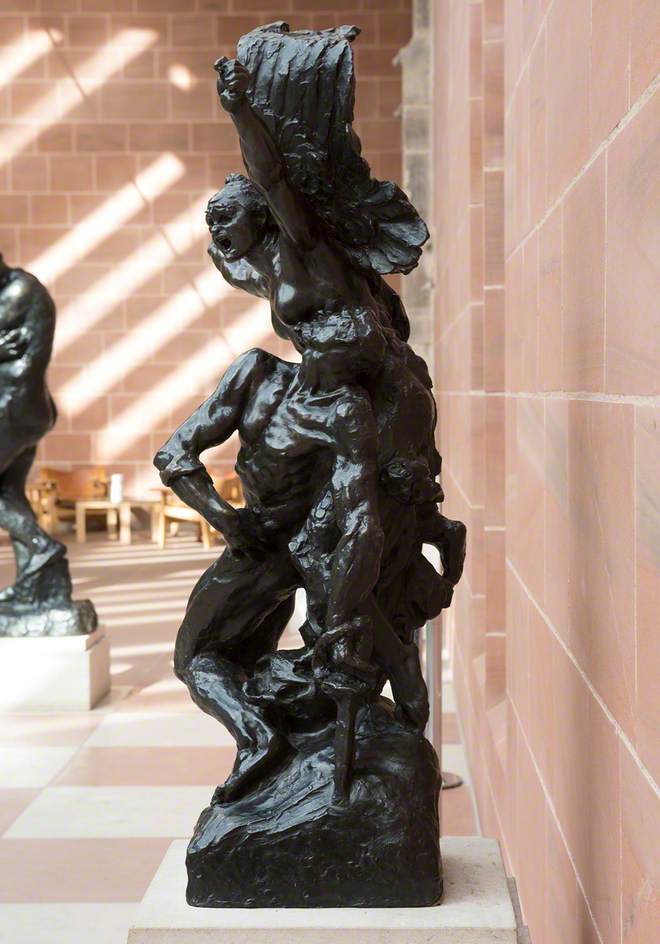
For this activity, students will create an artwork that responds to the work of Brancusi or Serra or Rodin. Richard Serra, the other sculptor whose work is represented in this exhibition, admired and responded to Brancusi’s work.
Brancusi admired and responded to Rodin’s work. Ask students to discuss The Kiss in terms of Brancusi’s statement: “Beauty is the harmony of opposing things.” Brancusi often made short statements, or aphorisms, about his art and art in general. What do students think Brancusi borrowed from Rodin? What do they think he rebelled against? Challenge them to write a dialogue between the master Rodin and his student before Brancusi left to work on his own. Compare Brancusi’s The Kiss to Auguste Rodin’s The Kiss from 1901-04. Brancusi worked for the French master sculptor, Auguste Rodin, for a month before breaking out on his own. What do students notice about the way Brancusi manipulated the limestone? In many of his creations he was interested in the contrast of this roughness (or archaic quality) in opposition to the sophisticated polish of the bronzes or marbles. (If possible, show the students a sample.) Although limestone was a humble material, cheap and extensively used for buildings, it had a “real” quality for Brancusi, as it was direct and rough (brut). 
Tell them that many buildings in Paris from the late 19 th and early 20 th century were built with limestone, but it has been used in architecture for longer than that-most notably to build the Great Pyramid in Egypt.
What do they think the sculpture would feel like if they could touch it? Ask students to describe the material. What are the two figures doing? How has Brancusi depicted figures differently than in other sculptures they have seen? Ask them to describe what is happening in the sculpture. Look together at Constantin Brancusi’s The Kiss (1916). 52.Ħ Stemp, Constantin Brancusi: The Essence of Things.ħ Gimenez and Gale, Constantin Brancusi: The Essence of Things, p. 52ĥ Gimenez and Gale, Constantin Brancusi: The Essence of Things, p. 19.ģ Stemp, Constantin Brancusi: The Essence of Things.Ĥ Alexandra Parigoris in Gimenez and Gale, Constantin Brancusi: The Essence of Things, p. His sculptures bring all of these elements together.ġ Gimenez and Gale, Constantin Brancusi: The Essence of Things, p. The tensions between prehistoric and classical, modern and traditional, abstract and figurative 7 can be seen in his craftsman-like approach to direct carving, combined with his use of classical lines and his more modern abstraction of form. He once said, "Beauty is the harmony of opposing things," 6 and he did resolve certain art historical tensions within his work. 5īrancusi not only achieved unity through carving from solid pieces of material, but also through bringing together disparate artistic elements. Some say it is because it was directly carved but others argue that he considered it a turning point because of the infinite quality or "seamless unity" of the work, because "the work and its image were one and the same, entirely contained within the stone block." 4 Another explanation is that he believed it led him to sculpt partial figures or fragments-torsos or heads without the rest of their bodies-also a revolutionary break from sculptors such as Rodin. Rather, they respond to the intrinsic nature of the material into which they are carved.īrancusi considered The Kiss a turning point in his artistic career. 3 None of the versions were based on a preparatory model. The Kiss is an example of direct carving and of Brancusi's deep knowledge of the properties of the materials he worked with. In this 1916 version in limestone, the arms are flatter, the bodies elongated, and the hair more distinctly linear than in earlier versions. He made many versions of The Kiss, beginning in 1907-08 with a plaster version. In each version, the profile of the eyes of the figures merge until the halves together look like a single eye viewed straight on. 

The figures are cut under the breastline and the fragmented bodies lie directly on the floor. Exemplifying unity coupled with duality, two figures become one as they emerge from a single block of material.

One of his best-known sculptures, The Kiss, depicts a nearly indistinguishable man and woman embracing and locked in a kiss. He argued, "Nothing can grow in the shadow of a great tree." While Rodin used many assistants to help him cast or carve his sculptures, Brancusi preferred to create his with his own hands, making an intimate connection with the materials, most often through direct carving. He worked for the French master sculptor Auguste Rodin (1840-1917) for only a month in 1907 before leaving. Paris, 1957) broke from many of the conventions of sculpture. "Simplicity is resolved complexity." 1 Constantin BrancusiĬonstantin Brancusi (b.








 0 kommentar(er)
0 kommentar(er)
